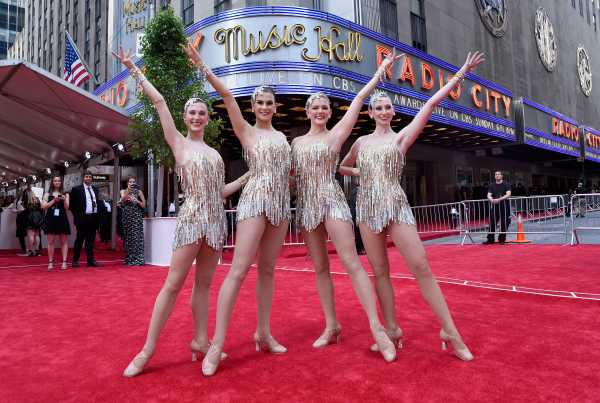

Radio City Music Hall’s Christmas Spectacular, a holiday tradition since 1933, is getting a high-tech upgrade: 100 of Intel’s Shooting Star Mini drones will now join the Rockettes onstage.
The tiny robots will come together for a new finale number themed around the North Star. Director Sam Buntrock, best known for his 2005 revival of Sondheim’s elegantly tacky ’80s classic Sunday in the Park With George (which also centers on a light show), explained the purpose of the drones’ musical sequence to Variety, saying, “It traces the North Star through time, and fragments that into points of light that then get carried forth into the world, in the tiny points of light on a Christmas tree or on a candle. It has this sense that the Christmas lights have an origin story — like Batman.”
This is the first time that the Shooting Star Mini drones have been used in an indoor performance, and they’ll do it 200 times
Also like Batman, this musical number will be high-tech and expensive in more ways than one: It will reportedly feature one of the biggest 8K LED displays ever made, along with digital projections designed by San Francisco “interactive art and creative studio” Obscura Digital, which was acquired by the Madison Square Garden Company’s MSG Ventures “technology group” in November 2017.
This is the first time that the Shooting Star Minis have been used in an indoor performance, but it is not the first time Intel has done something complicated or attention-grabbing with drones: You may have seen 1,218 full-size Shooting Stars at the 2018 Winter Olympics opening ceremony, or 300 at Lady Gaga’s 2017 Super Bowl halftime show. This is also not the first time the Madison Square Garden Company–owned Radio City has made a questionably massive investment in novelty technology: Elements requiring the wearing of 3D glasses have been a part of the show since 2011.
The Rockette show is notably different because it will be performed 200 times. This year’s Spectacular will run 30 shows a week from November 9 to January 1, and will, as always, also feature real camels, sheep, and donkeys who will eat 340 bales of hay and 560 loaves of seven-grain bread and haunt the streets of midtown Manhattan in the middle of the night, which is when they are supposedly permitted to leave the Music Hall for some exercise. (Has anyone actually seen this? Please DM!)
The motivation for both parties in this partnership is clear: Radio City had trouble selling tickets last year, and its parent company had trouble making up the difference in revenue. Drones have been popular Christmas gifts for children for several years now(!) and it stands to reason that this move could help engage a new audience. Intel is in a bit of a rut following the somewhat scandalous resignation of CEO Brian Krzanich, who left the company this summer after 35 years. It can use some Christmas magic.
Natalie Cheung, general manager of Intel’s drone light shows, told VentureBeat that Intel’s drone technology enables “billions of color combinations,” which made the show highly customizable. The drones are each about a foot long, weigh around 8 ounces, and are made of Styrofoam. They’re set up with pre-programmed algorithms but supervised by a person (one pilot can control up to 100 at once), and they don’t need GPS to fly — which is key, considering the complexity at work here and the fact that GPS can be imprecise and fallible.
Intel also claims this will be the world’s largest interior drone show, which is not true because I can personally attest to having seen 200 drones fly around Drake’s head during a show at the Barclays Center less than two months ago. That production was the handiwork of a company called Verity Studios, which also coordinates drone casts for Cirque du Soleil and Metallica and raised $18 million in Series A funding this summer. It’s part of a trend of delivering an appearance of once-in-a-lifetime spectacle, to justify escalating ticket prices and satisfy Generation Z’s obsession with Instagrammable “experiences.”
What could differentiate the Intel spectacle would be if the drones were allowed to hover over the audience in addition to the performers. This was not the case at Drake’s show, and though the Federal Aviation Authority doesn’t care what anyone does with drones when they’re inside, it has generally been taboo ever since a drone crashed (albeit harmlessly) into the audience of a Muse show at London’s O2 Arena in April 2016. But when Intel debuted the Shooting Star drones at the Consumer Electronics Showcase keynote in Las Vegas in January, they flew over the heads of attendees there, and while they aren’t yet a consumer-facing product, the primary innovation Intel is selling here is their safety — light, soft, reliable, etc.
The show will almost definitely be safe. I hate to be crass, but this better be true — each Rockette makes about $1,500 a week, and Drake reportedly made close to $9 million during his recent week at Madison Square Garden. These ladies are not getting paid enough to risk personal injury that would definitely also become a viral video. And in defense of my generation, which I’m sure everyone will blame for this rude robotic intrusion on organic Christmas magic, the last time I saw the Rockettes, I noted only baby boomers taking out their phones and taking videos of the entire thing whilst I and my teen sisters sat in quiet awe.
The Shooting Star Mini is eventually supposed to be used for search-and-rescue operations but is currently not allowed to, due to regulatory hurdles. If you do spend $150 to see them at Radio City, review them honestly on your comment card and maybe help them follow their dreams.
Sourse: vox.com






